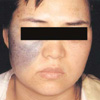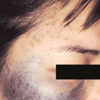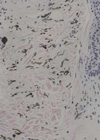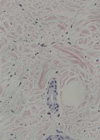INTRODUCTION
Ota's nevus was first described in 1939 by Ota (1). It is usually characterized by unilateral, mottled, blue or dark brown macules occurring in the sclera and the surrounding skin innervated by the first and second branches of the trigeminal nerve. Ota's nevus is usually congenital but may appear in early childhood or in puberty. Acquired, bilateral nevus of Ota-like macules (ABNOM) was first described in 1984 by Hori et al. (2). It is located bilaterally on the face and is blue-brown or slate-gray in color. These macules usually appear in the third or fourth decade of life in women and only rarely in men. Pigmented macules are absent in the mucous membranes of oral cavity, nose, or eyes.
There has been debate as to whether ABNOM is a part of the Ota's nevus spectrum. We report here a case of ABNOM associated with Ota's nevus to discuss the relations between two entities.
CASE REPORT
A 36-yr-old Korean women visited our clinic with dark bluish patch on the right cheek and right conjunctiva since birth. She also had mottled brownish macules on both forehead and both lower eyelids that have developed 3 yr ago (Fig. 1, 2). She was taking anti-hypertensive drugs for 1 yr. There was no family history of abnormal cutaneous pigmentation. Skin biopsy specimens taken from the right cheek and left forehead all showed scattered, bipolar or irregular melanocytes in the dermis (Fig. 3, 4). Immunohistochemical study revealed melanocytes in the dermis were positive in Fontana-Masson stain and S-100 protein. By clinical and histopathological findings, we diagnosed lesion on the right cheek area as Ota's nevus and those on both forehead and both lower eyelids as ABNOM.
DISCUSSION
Ota's nevus, originally described as nevus fuscocaeruleus ophthalmomaxillaris by Ota and Tanino in 1939, is a nevus of dermal melanocytes (1). It is more prevalent in orientals and is said to occur in up to 0.8% of the dermatologic outpatients in Japan but also occurs in Korean, Chinese, blacks, and whites (3, 4). The sex ratio is 1:4.8, women being more frequently involved than men (5). Ota's nevus most often appears in the perinatal period or around puberty. A study in Japan by Hidano et al. (5) of 240 patients revealed that onset of the nevus was at birth or in the first few months of life in 48%, between the ages of one and ten years in 11%, between eleven and twenty years in 36%, and between twenty-one and twenty-six years in only 5% of cases. It is usually unilateral and is located in the areas innervated by the first and second branches of trigeminal nerve. The pigmentation of Ota's nevus is composed of flat, blue-black or slate-gray macules intermingled with brown, small, flat spots. The intensity of the pigmentation may be influenced by fatigue, menstruation, insomnia, and weather (5). Based on the distribution and the extent of pigmentation, Ota's nevus has been classified into four types (6): mild, Type I; moderate, Type II; intensive, Type III; and bilateral, Type IV. Bilateral involvement is about 10% (1, 7). Noncutaneous pigmentation, which is not addressed in this classification, may occur and often involves the conjunctiva, sclera, and tympanic membrane. Less frequently, the nasal mucosa, palate, pharynx, cornea, iris, uveal tract, and fundus are involved. Histologic studies show bipolar to stellate melanocytes widely scattered in the reticular dermis.
Acquired, bilateral nevus of Ota-like macules (ABNOM), first described by Hori et al. in 1984, is classified in a group of circumscribed dermal melanoses (2). It is prevalent in Asian people. The incidence as reported by Sun et al. in Taiwan was 0.8% (8). It is usually appears in the third or fourth decade of life and showed a marked preponderance of females (2). ABNOM is usually characterized by blue-brown or slate-gray patches occurring bilaterally on the forehead, temples, eyelids, cheeks and nose. Histopathologic studies showed dermal melanocytes, bipolar or oval in shape, scattered in the upper and middle portions of the dermis. ABNOM should be clinically and histologically differentiated from bilateral Ota's nevus, Riehl's melanosis and melasma. ABNOM differs clinically from bilateral Ota's nevus in the following aspects (2, 9); (1) ABNOM is an acquired disease that age of onset ranges from 16 to 69 and averaged 36.3 yr while nevus of Ota usually present at birth or develops within 1 yr of life or in adolescence: (2) There is no mucosal pigmentation in ABNOM, while bilateral Ota's nevus may involve conjunctiva, oral, or nasal mucosa as well as tympanic membrane: (3) Pigmentation of ABNOM is not as intensive as the bilateral Ota's nevus. Histologically, only dermal melanin and melanophages but no dermal melanocytes are found in the lesions of Riehl's melanosis and melasma. This is contrast to ABNOM and Ota's nevus as mentioned earlier.
There are also opinions that ABNOM is not a separate entitiy, but "symmetrical variety of bilateral Ota's nevus" (10). In our case, we diagnosed lesion on the right cheek area as Ota's nevus and those on both forehead and both lower eyelids as ABNOM by clinical and histologic findings. This case may support the view that ABNOM is a separate entity from bilateral Ota's nevus. However, we could not exclude the possibility that lesions on both forehead and both lower eyelids may be attributed to the activation of latent dermal melanocytes in Ota's nevus by unknown cause.




 PDF
PDF ePub
ePub Citation
Citation Print
Print






 XML Download
XML Download